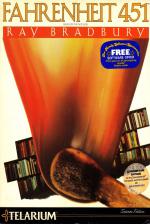
C&VG
 1st September 1985
1st September 1985
Categories: Review: Software
Author: Keith Campbell
Publisher: Telarium
Machine: Commodore 64
Published in Computer & Video Games #47
Fahrenheit 451
Fahrenheit 451 by Ray Bradbury is not a recent book (first published in Great Britain in 1954), nor is it one of my favourites. In fact, many years ago when I first attempted to read it, I found it very heavy going.
However, as I had a copy of the Adventure game of the same name sitting on the shelf, I thought it was about time I had another try. The story still didn't really hold my interest but I persevered, hopeful that I would enjoy the game all the more for doing so.
The story centres around Guy Montag, a fireman in an era where fires are started by the fire brigade rather than extinguished. The objective of these fires is to rid the world of books which are illegal. Many a citizen caught with one in his possession had lost not only his rare and treasured book, but also his home and often his life, at the hands of the firemen.

The main pre-occupation of the populace is to participate in an interactive form of television, whose screens cover all four walls of a room, and they have little interest in literature which is considered subversive. Guy's wife is hooked on this medium and takes an interest in nothing else. So meanwhile, Guy meets up with a girl called Clarissa who has the profound effect of showing him the error of society's ways and inspiring him to become a member of the underground movement who keep and cherish books.
All the time he is under the threat from mechanical hounds who recognise and relentlessly pursue a subversive by sniffing out his unique chemical "index" which is registered on a master file. Once trapped, it's not a fierce canine bite that stops a victim, but a deadly hypodermic ejected from the hounds' jaws.
The game starts in New York's Central Park with the sound of mechanical hounds not too far away. As Guy Montage, you must flee and to survive you need help from members of the underground. Every way you run seems to lead you straight to the hounds. But would you believe that you find yourself standing beside a pile of dead leaves? Guess what lies under it!

With little more ado, I had the grating up and was down below ground, to emerge near a fountain on Fifth Avenue. This is where a good geographical knowledge of New York would have been handy, as before long a complete stranger had sidled up to me and suggested I make my way to E48-49 and utter a somewhat meaningless phrase. My being on W57-58 suggested the journey should not be too difficult, but strolling around to get my bearings gave the hounds a field day and kept the drive of my Commodore constantly spinning!
Little by little, replay by replay, I managed to explore most of New York, entering buildings and subways, until I found the use for a key object. Then things began to fall into place!
It was when I failed to make the nurse in the hospital understand what I was telling her that I decided perhaps the instruction book might be worth a browse. Indeed it was - in fact, it is essential reading if you are to get the most out of the game. Within no time I had discovered at what times the hounds patrolled Fifth Avenue and how to tell the time!
That doesn't mean the hounds did not remain a constant threat, for it takes a bit of planning and some luck to keep out of their way, even when you know they're coming!
Life in the underground is quite exciting when you know the secret signs and can converse in the right lingo. Being bookworms, the underground use literary quotations as recognition passwords. So I found myself on the platform of a subway station saying to a maintenance worker wielding a pneumatic drill: "Rise up, my love, my fair one, and come away." Nothing special happened, as they say, which on reflection, was probably just as well. So off I went to find another little known phrase or saying...
Fahrenheit 451, the game, is far more enjoyable than Fahrenheit 451, the book - I think so anyway. Like the book, it takes quite a bit of getting into but it is more rewarding. Once you have mastered the art of going about things as a member of the underground, there are all sorts of surprises in store for you.
The trouble that plagues this game, like all others on the Commodore, is its dreadfully slow speed. Against that, the game is big - two double-sided discs - with graphics at most locations. Some special commands are available to help you, such as LOCATION which tells you your New York street co-ordinates. Once you get the hang of this one and realise that the roadway counts as one location between each sidewalk, navigation is fairly easy.
There are plenty of buildings to enter and people to meet - are they friend or foe? You have to design whether to risk showing them "the sign" - for firemen hemselves are beginning to recognise it! Can the Phantasyphones be believed when they hint that Clarissa is still alive? If their message is not just fantasy, will you ever be able to find her?
Fahrenheit 451 is an excellent game and is available on disc only for the Commodore 64 and Apple II at £19.95. It is one of the Telarium (ex Trillium) series from Spinnaker Software.





















